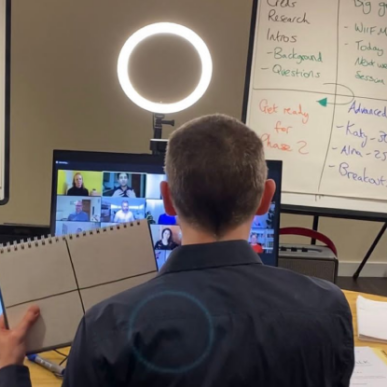‘Online meetings can be awkward, fraught with tech problems and distracting in many ways that face-to-face meetings aren’t‘
5 Ways To Make Virtual Meetings Better For Your Team
Virtual technology has undoubtedly revolutionised the humble team meeting, but has it changed for the better?
Although online conferencing platforms were growing in popularity before the pandemic, the coronavirus crisis saw them boom – so much so that Zoom’s sales increased by a whopping 370% in the last three months of 2020.
Even though the world is opening up again, many teams are opting to stick with online meetings.
However, if poorly done, they can be awkward, fraught with technological problems and distracting. As a result, staff can become frustrated, bored, and ultimately less engaged.
So, how can you make virtual meetings better so that your team stays as positive, engaged and motivated as they would do if it were face to face?
Here are five simple tips to make your virtual meetings run more smoothly.
Make your meeting easy to find
“Sorry I’m late; I couldn’t find the right meeting link.”
Sound familiar?
Lots of online meetings mean lots of call links. Unless you keep a meticulous online calendar, it can be tricky to find the correct link at the right time – especially if all your email invitations say something like ‘Joe Bloggs is inviting you to a Zoom meeting’.
The answer? Make it easier for people to find your meeting. When scheduling it within the online platform, make sure you edit the topic or subject box to something relevant, so your attendees know what it’s about: e.g., ‘Client Feedback Meeting’.
Then, when you’re ready to send the calendar invite, make sure that the subject heading of the email also matches that of the meeting. You can add the meeting agenda to the body of the invite and attach any relevant documents too.
And here’s an extra tip to make things even simpler! As well as generating the meeting link, many online platforms also create lines of additional phone numbers and links that aren’t relevant. If you don’t need it, remove it. Take a second to delete any redundant information, and only send the one call link and meeting passcode. Your colleagues will thank you for it!
No phones please!
While it can seem convenient to join a meeting from anywhere using your phone, it’s challenging to stay engaged in a meeting if you’re watching it on a tiny screen.
It’s easy to see why. For example, it’s difficult for people to see any detail if you’re sharing slides, leading to eye strain over long periods. Trying to mute or unmute can become an absolute nightmare, and if a person is holding their phone with their camera on, the screen can switch from portrait to landscape – which becomes a significant distraction.
Set expectations before your meeting that people should attend using a computer or laptop.
Give them a camera break
Many online meetings attempt to replicate a face-to-face meeting by requiring attendees to have their cameras switched on.
It’s true that for communication to be effective, we need to see one another. For a person speaking, body language, including facial expressions and hand gestures, is one of the most critical elements in giving congruency to your message, telling people how to feel about the information that you’re giving them.
But there’s no question that people find being ‘on camera’ a much more exhausting experience than attending a meeting in person. A recent study from Stanford University showed that seeing mirror images of ourselves during online meetings is a significant contributing factor to ‘Zoom fatigue’. It can even result in people developing a negative self-image.
So, if you’re delivering a long presentation – give your attendees a camera break.
Ask them to have cameras on at the start, towards the end and for questions or discussion so that you can still communicate as a team. Allowing people to have their cameras off during your presentation may enable them to concentrate more on your message rather than worrying about what they look like.
Height, light and mic
If you’re going to be speaking on camera, then it’s essential to take five minutes before you begin to check your technical set-up and make adjustments.
Make sure that your camera is at the correct height and that your face is well lit so that your audience can see you and read your facial expressions. This will ensure that you’re communicating your message in the clearest possible way.
Using an external microphone can also make a real difference to the sound quality. Built-in laptop microphones often sound tinny and distorted – but adding a small, clip-on microphone can eliminate background noise.
Be a great facilitator – and stay in control
Chairing a virtual meeting requires a little more’ stage direction’ than face to face.
In face-to-face meetings, we can use gestures and clear eye contact with individuals to invite people to speak. But in a virtual meeting, this isn’t possible. To make ‘eye contact,’ you need to gesture and look into your camera. However, during online meetings, gesturing to one person is the same as gesturing to every person, so things can quickly become confusing, with people talking over one another.
To help facilitate a smoother meeting, give your attendees clear direction about what will happen, when and how.
Explain to your audience at the start how you want them to interact. You may wish to use a chatbox or a ‘hand raising’ function within the online platform to invite people to speak or ask questions. It may be a case of giving people advance warning that you’ll be asking for their feedback at the end of your presentation, and you’ll invite them to talk individually.
Make sure that you look at the camera when you’re asking for feedback so that you’re establishing ‘eye contact’. Also, use a palms-up gesture to invite people to have their say.
If you have many attendees, consider having a separate ‘facilitator’ to run the meeting for you. Someone who can keep an eye on the chatbox and help manage any questions or comments. This role is vital if you run hybrid meetings to ensure all staff feel included and engaged.
And a bonus tip?
One of the best bits about face-to-face team meetings is the tray of biscuits to share over a coffee beforehand. If you’re having a special meeting, why not consider sending your team members a little biscuit through the post, such as these letterbox biscuit gifts? It’s a sure-fire way to boost team morale.
We wish you all the best with your virtual meetings and we are to help coach you and your team to make sure you gain the very best results. You can even book us to attend your next meeting to give your team an inspiring and practical skills masterclass. Get in touch to find out more!
Written by Jen Bartram




















